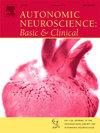Impaired exercise hemodynamic responses in patients with HFpEF without a sympathetic vasoconstrictor reserve
IF 3.3
4区 医学
Q2 NEUROSCIENCES
引用次数: 0
Abstract
Impaired exercise hyperemia and blunted vasoconstrictor responsiveness have been reported in patients with heart failure with preserved ejection fraction (HFpEF). However, there is considerable heterogeneity in the degree to which vasodilatory capacity and sympathetic vasoconstrictor reserve are diminished. Given the integration of both vasodilation and vasoconstriction to appropriately regulate blood flow during exercise, we hypothesized that patients with HFpEF who are unable to vasoconstrict to sympatho-excitation (i.e., a cold pressor test; CPT; non-constrictors) have blunted leg blood flow (LBF) responses to single leg knee extensor (SLKE) exercise compared to patients with HFpEF who are able to vasoconstrict in response to sympatho-excitation (constrictors). Forty-three patients diagnosed with HFpEF underwent a CPT and performed submaximal and peak SLKE exercise while heart rate, blood pressure and common femoral artery blood flow were measured. The percent change in leg vascular conductance (LVC) during the CPT was used to categorize participants as non-constrictors (+26 ± 24%Δ LVC; n = 22, 16 female) or constrictors (−15 ± 14%Δ LVC; n = 21, 13 female). During submaximal SLKE exercise (7.5 watts) non-constrictors had a smaller increase in LBF (non-constrictors: Δ 1139 ± 425 ml/min; constrictors: Δ 1497 ± 454 ml/min; P = 0.011) and LVC (non-constrictors: Δ 9.8 ± 3.4 ml/min/mmHg; constrictors: Δ 13.3 ± 4.5 ml/min/mmHg; P = 0.007). LBF at peak SLKE exercise was also less in non-constrictors compared to constrictors (P = 0.033). In summary, patients with HFpEF without a sympathetic vasoconstrictor reserve present with impaired hemodynamic responses to exercise.
无交感血管收缩剂储备的HFpEF患者运动血流动力学反应受损
在射血分数保存(HFpEF)的心力衰竭患者中,有报道称运动充血受损和血管收缩反应迟钝。然而,在血管舒张能力和交感血管收缩储备减弱的程度上存在相当大的异质性。考虑到在运动过程中血管舒张和血管收缩的结合可以适当地调节血流量,我们假设无法血管收缩到交感神经兴奋(即冷压试验)的HFpEF患者;CPT;与在交感神经兴奋(收缩因子)下血管收缩的HFpEF患者相比,非收缩因子患者在单腿膝关节伸肌(SLKE)运动中腿部血流(LBF)反应迟钝。43例确诊为HFpEF的患者接受了CPT,并进行了亚最大值和峰值SLKE运动,同时测量了心率、血压和股总动脉血流。CPT期间腿部血管传导(LVC)的百分比变化用于将参与者分类为非收缩者(+26±24%Δ LVC;n = 22,16名女性)或缢蛏(- 15±14%Δ LVC;N = 21,13名女性)。在次最大SLKE运动(7.5瓦)中,非收缩组的LBF增加较小(非收缩组:Δ 1139±425 ml/min;收缩器:Δ 1497±454 ml/min;P = 0.011)和LVC(非收缩血管:Δ 9.8±3.4 ml/min/mmHg;收缩:Δ 13.3±4.5 ml/min/mmHg;p = 0.007)。与收缩组相比,非收缩组在SLKE运动高峰时的LBF也更少(P = 0.033)。总之,没有交感血管收缩储备的HFpEF患者对运动的血流动力学反应受损。
本文章由计算机程序翻译,如有差异,请以英文原文为准。
求助全文
约1分钟内获得全文
求助全文
来源期刊
CiteScore
5.80
自引率
7.40%
发文量
83
审稿时长
66 days
期刊介绍:
This is an international journal with broad coverage of all aspects of the autonomic nervous system in man and animals. The main areas of interest include the innervation of blood vessels and viscera, autonomic ganglia, efferent and afferent autonomic pathways, and autonomic nuclei and pathways in the central nervous system.
The Editors will consider papers that deal with any aspect of the autonomic nervous system, including structure, physiology, pharmacology, biochemistry, development, evolution, ageing, behavioural aspects, integrative role and influence on emotional and physical states of the body. Interdisciplinary studies will be encouraged. Studies dealing with human pathology will be also welcome.

 求助内容:
求助内容: 应助结果提醒方式:
应助结果提醒方式:


